- ¿Qué es un parque nacional?
-
- Mar de las Calmas (propuesta)
- Aigüestortes i Estany de Sant Maurici
- Cabrera Archipelago
- Cabañeros
- Caldera de Taburiente
- Doñana
- Garajonay
- Atlantic Islands of Galicia
- Monfragüe
- Ordesa y Monte Perdido
- Picos de Europa
- Sierra de Guadarrama
- Sierra de las Nieves
- Sierra Nevada
- Tablas de Daimiel
- Teide
- Timanfaya
- La Red de un vistazo
- ¿Cómo funciona La Red?
- Cartography
- Central Booking
Transectos: Punta de la Ermita
Transectos: Punta de la Ermita
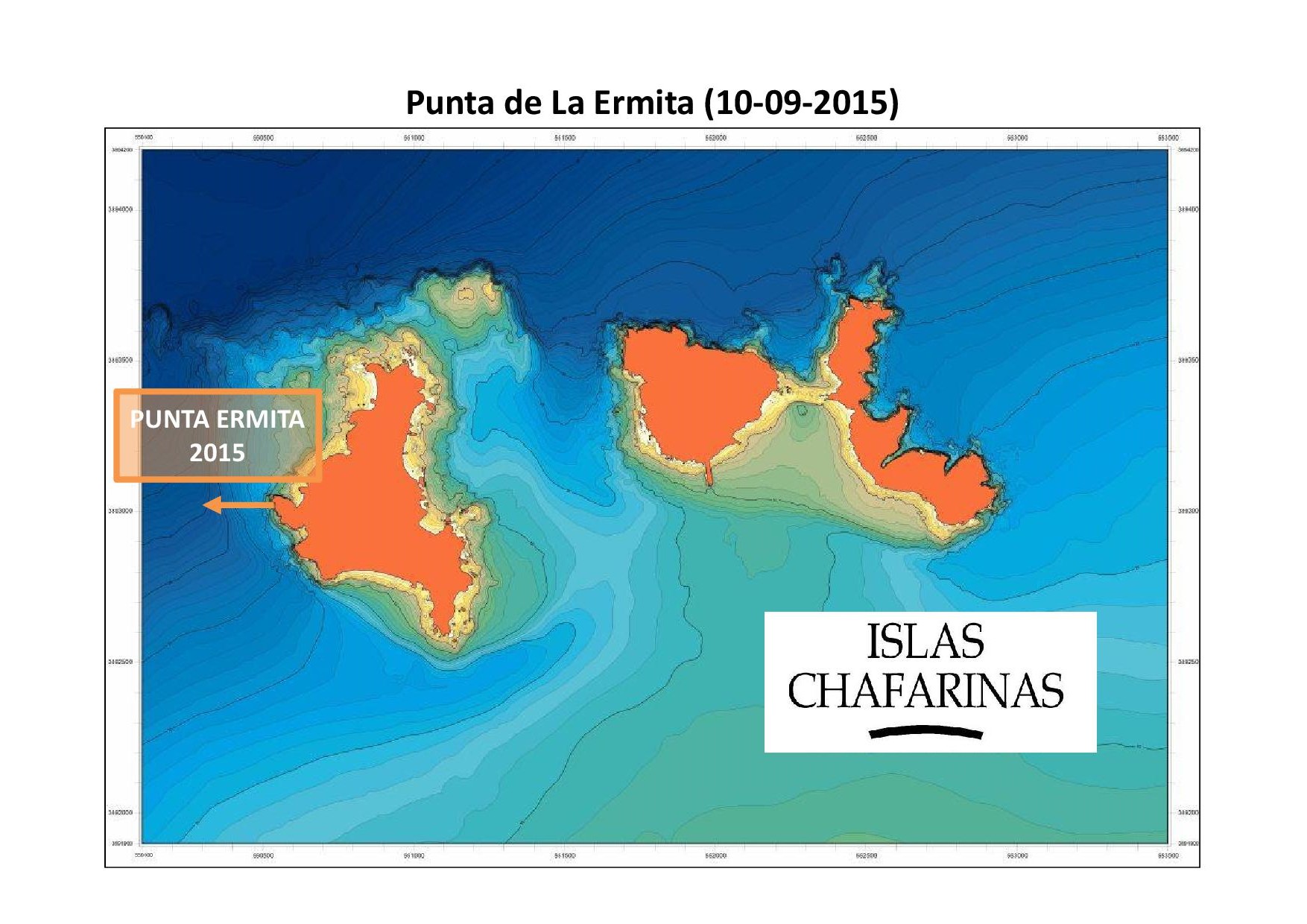 Resumen de las observaciones realizadas en cada metro de profundidad en Punta de la Ermita (Chafarinas). Autor: Luis Sánchez Tocino. Universidad de Granada
Resumen de las observaciones realizadas en cada metro de profundidad en Punta de la Ermita (Chafarinas). Autor: Luis Sánchez Tocino. Universidad de Granada
 Representación del relieve del terreno en Punta de la Ermita
Representación del relieve del terreno en Punta de la Ermita
 La Punta de la Ermita es la parte más occidental de la Isla del Congreso y, por tanto, de las Islas Chafarinas.
0m. Justo por encima de las algas mediolitorales, se observa el cinturón del cirrípedo (Chthamallus stellatus).
La Punta de la Ermita es la parte más occidental de la Isla del Congreso y, por tanto, de las Islas Chafarinas.
0m. Justo por encima de las algas mediolitorales, se observa el cinturón del cirrípedo (Chthamallus stellatus).
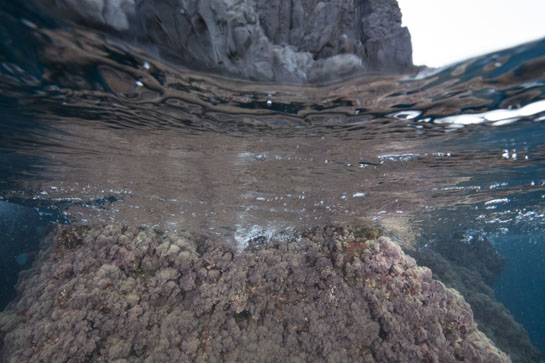 0m. Diferentes especies de algas rojas dominan el mediolitoral inferior y la parte superior del piso infralitoral.
0m. Diferentes especies de algas rojas dominan el mediolitoral inferior y la parte superior del piso infralitoral.
 –1m. El alga roja Haliptilon virgatum predomina a esta profundidad.
–1m. El alga roja Haliptilon virgatum predomina a esta profundidad.
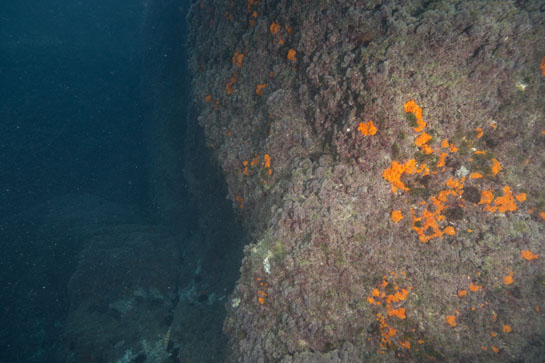 –2m. El coral naranja (Astroides calycularis) aprovecha las zonas más umbrías para asentarse.
–2m. El coral naranja (Astroides calycularis) aprovecha las zonas más umbrías para asentarse.
 –3m. Varios fredis (Thalassoma pavo) nadan cerca de la pared.
–3m. Varios fredis (Thalassoma pavo) nadan cerca de la pared.
 –4m. La pared rocosa cae formando grandes escalones. En la imagen se pueden ver varios ejemplares del alga parda (Halopteris scoparia).
–4m. La pared rocosa cae formando grandes escalones. En la imagen se pueden ver varios ejemplares del alga parda (Halopteris scoparia).
 –5m. La verticalidad de la pared junto con el aumento de la profundidad, favorecen la presencia de un gran número de colonias de Astroides calycularis.
–5m. La verticalidad de la pared junto con el aumento de la profundidad, favorecen la presencia de un gran número de colonias de Astroides calycularis.
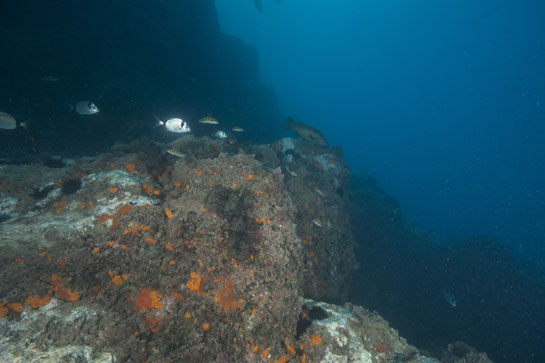 –6m. Todavía se observan algunos grandes serránidos en Chafarinas, a pesar de la presión a que les somete la pesca submarina. En la imagen un tachano o gitano (Myctireoperca rubra).
–6m. Todavía se observan algunos grandes serránidos en Chafarinas, a pesar de la presión a que les somete la pesca submarina. En la imagen un tachano o gitano (Myctireoperca rubra).
 –7m. El llamativo color de este extraplomo es debido al coral naranja y a las algas rojas calcáreas.
–7m. El llamativo color de este extraplomo es debido al coral naranja y a las algas rojas calcáreas.
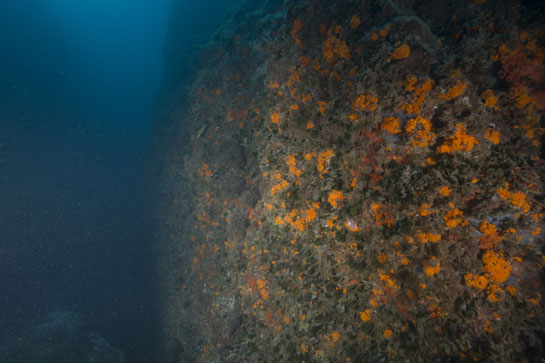 –8m. Entre las colonias de Astroides calycularis se desarrollan numerosos ejemplares del alga verde (Flabellia petiolata), de ambientes umbríos
–8m. Entre las colonias de Astroides calycularis se desarrollan numerosos ejemplares del alga verde (Flabellia petiolata), de ambientes umbríos
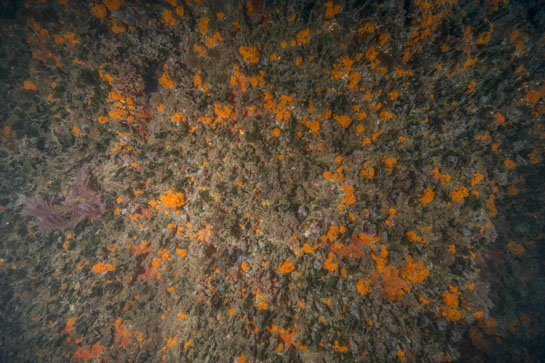 –9m. En la parte izquierda de la imagen,un ejemplar del alga invasora del género Asparagopsis.
–9m. En la parte izquierda de la imagen,un ejemplar del alga invasora del género Asparagopsis.
 –10m. A esta profundidad finaliza la pared vertical y comienza un fondo menos inclinado formado por grandes bloques de piedra.
–10m. A esta profundidad finaliza la pared vertical y comienza un fondo menos inclinado formado por grandes bloques de piedra.
 –11m. Los bloques de piedra se encuentran totalmente cubiertos por diferentes especies de algas pardas, entre ellas Halopteris scoparia.
–11m. Los bloques de piedra se encuentran totalmente cubiertos por diferentes especies de algas pardas, entre ellas Halopteris scoparia.
 –12m. Un gran gitano (Myctireoperca rubra) nada entre un numeroso grupo de castañuelas (Chromis chromis).
–12m. Un gran gitano (Myctireoperca rubra) nada entre un numeroso grupo de castañuelas (Chromis chromis).
 –13m. Entre las algas pardas se aprecian varios ejemplares de algas del género Asparagopsis, originarias de Australia y Nueva Zelanda.
–13m. Entre las algas pardas se aprecian varios ejemplares de algas del género Asparagopsis, originarias de Australia y Nueva Zelanda.
 –14m. Las especies de hábitats umbríos como Astroides calycularis, esponjas rojas o el alga verde (Flabellia petiolata), aprovechan este extraplomo para desarrollarse.
–14m. Las especies de hábitats umbríos como Astroides calycularis, esponjas rojas o el alga verde (Flabellia petiolata), aprovechan este extraplomo para desarrollarse.
 –15m. La competencia por los sustratos rocosos a estas profundidades es muy alta.
–15m. La competencia por los sustratos rocosos a estas profundidades es muy alta.
 –16m. El bosque de algas se extiende sobre el fondo rocoso dificultando el asentamiento de los invertebrados.
–16m. El bosque de algas se extiende sobre el fondo rocoso dificultando el asentamiento de los invertebrados.
 –17m. Un numeroso grupo de castañuelas nada sobre las algas.
–17m. Un numeroso grupo de castañuelas nada sobre las algas.
 –18m. Los reyezuelos o salmonetes reales (Apogon imberbis), son peces con un llamativo color rojo. Presentan hábitos nocturnos y durante el día suelen encontrarse en el interior de cuevas o grietas. Como curiosidad, los machos incuban los huevos en el interior de la cavidad bucal. En la parte inferior derecha, aparece un hilo de pesca cubierto de algas calcáreas.
–18m. Los reyezuelos o salmonetes reales (Apogon imberbis), son peces con un llamativo color rojo. Presentan hábitos nocturnos y durante el día suelen encontrarse en el interior de cuevas o grietas. Como curiosidad, los machos incuban los huevos en el interior de la cavidad bucal. En la parte inferior derecha, aparece un hilo de pesca cubierto de algas calcáreas.
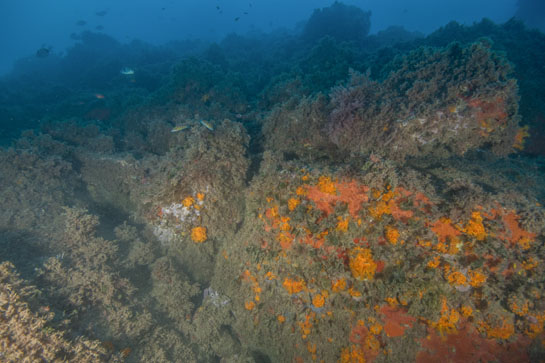 –19m. La presencia de las especies invasoras del género Asparagopsis, ha sido constante en este transecto.
–19m. La presencia de las especies invasoras del género Asparagopsis, ha sido constante en este transecto.
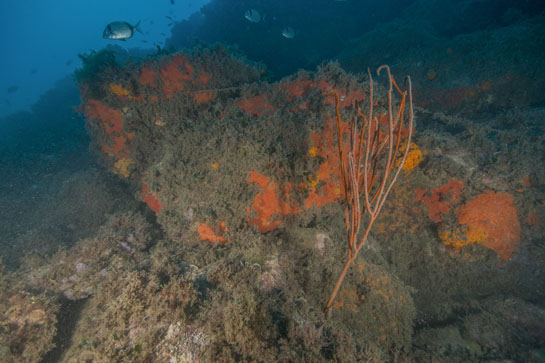 –20m. Varias mojarras (Diplodus vulgaris) nadan cerca de un ejemplar, en muy buen estado, de Ellisella paraplexauroides, en cuya parte superior se observa, en posición horizontal, un hilo de pesca.
–20m. Varias mojarras (Diplodus vulgaris) nadan cerca de un ejemplar, en muy buen estado, de Ellisella paraplexauroides, en cuya parte superior se observa, en posición horizontal, un hilo de pesca.
 –21m. Mojarras (Diplodus vulgaris) y julias (Coris julis) con las omnipresentes castañuelas, nadan sobre el bosque de algas pardas.
–21m. Mojarras (Diplodus vulgaris) y julias (Coris julis) con las omnipresentes castañuelas, nadan sobre el bosque de algas pardas.
 –22m. Hilos de pesca, justo por detrás de un ejemplar de Ellisella paraplexauroides medianamente epifitada. En esta zona los pescadores del cercano pueblo de Cabo de Agua, suelen calar diferentes artes de pesca, entre ellos los
palangres.
–22m. Hilos de pesca, justo por detrás de un ejemplar de Ellisella paraplexauroides medianamente epifitada. En esta zona los pescadores del cercano pueblo de Cabo de Agua, suelen calar diferentes artes de pesca, entre ellos los
palangres.
 –23m. A esta profundidad termina el fondo rocoso dando paso a uno de guijarros.
–23m. A esta profundidad termina el fondo rocoso dando paso a uno de guijarros.
This page provides information on cookies we use: We use our own and third-party cookies to keep your session active, personalise your experience, and collect anonymous statistics about how you use this website. You can choose to accept all cookies or select which types you'd like to allow. To learn more about the cookies we use, read our Cookies Policy.
We use two types of cookies on this site. First, there are Functional Cookies, which are essential for the website to work properly. They store session data to make your experience smoother and more convenient. On the other hand, Analytical Cookies collect information about how you use the portal, without personal data, helping us provide a better and more tailored service.
Introduction to the Use of Cookies on the MITECO.gob.es Website
Cookies are small files that are stored on your device when you visit a webpage. They are essential tools that help provide many of the services available on the information society. Among other things, cookies allow a webpage to store and retrieve information about a user's browsing habits or their device. Based on this information, they can be used to recognise the user and enhance the service provided.
Types of Cookies
Depending on the entity that manages the domain from which the cookies are sent and processes the data, there are two types of cookies: first-party cookies and third-party cookies.
There is also a second classification based on how long the cookies remain stored in the user's browser: session cookies and persistent cookies.
Finally, cookies can also be classified into five types based on the purpose for which the data is processed: technical cookies, personalisation cookies, analytics cookies, advertising cookies, and behavioural advertising cookies.
For more information on this, you can refer to the Guide on the use of cookies from the Spanish Data Protection Agency.
Cookies used on the website
The web portal of the Ministry for Ecological Transition and the Demographic Challenge uses Adobe Analytics, an analytics tool that helps website and application owners understand how visitors interact with their content. Adobe Analytics uses a small number of cookies to collect data and generate usage statistics for websites. This information is sent anonymously and is not shared with third parties under any circumstances. You can choose to accept or reject these cookies, as they do not affect the portal’s functionality. However, they help provide valuable information that allows us to offer a better and more tailored service. For more information about Adobe Analytics cookies and privacy, please refer to the following links:
Additionally, pages featuring content from social network X will only set cookies if the user is logged into the X site. For more details on these cookies, please refer to the following link: Privacy on Social Network X
Finally, a technical cookie named MITECO-compliance is stored, which is a first-party, technical, and session-based cookie. It manages user consent for the use of cookies on the website, remembering which users have accepted them and which have not, ensuring that those who have accepted are not shown cookie consent messages at the top of the page. This cookie is essential for the proper functioning of the portal.
Cookies Policy Acceptance / Rejection
The Ministry for Ecological Transition and the Demographic Challenge gives you the option to accept or reject cookies that are not essential for the portal's operation. Upon accessing the portal, a message will be displayed in the centre of the page with information about the cookie policy and the following options:
· Firefox
· Chrome
· Safari